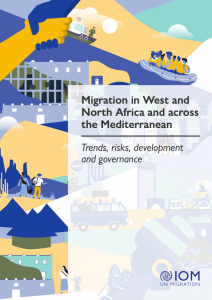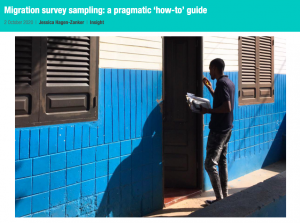The dangerous journeys that refugees and migrants undertake to move along the Central Mediterranean Route (CMR) as well as the protection incidents they face along the way, particularly in Libya, has been relatively well-documented by researchers, UN agencies and NGOs, and human rights organizations. Less is understood, however, about the role of smugglers who facilitate such journeys, or how smugglers are perceived by the refugees and migrants with whom they interact.
The chapter on Smuggling Networks and Dynamics on the CMR from the Mixed Migration Centre (MMC) provides insight into the profiles and motivations of smugglers, how they support or facilitate people’s journeys, as well as the role they play in protection incidents experienced by people on the move. It includes cross-regional comparisons and recommendations for policy and programming.
The research builds on data collected through the MMC's flagship data collection tool, the Mixed Migration Monitoring Initiative (4Mi). 4Mi carried out a total of 373 interviews with smugglers in West Africa (Niger and Mali) and North Africa (Libya) between May 2017 and September 2019 through a 70-question survey. These data are complemented by the 4Mi migrant survey carried out with 13,564 refugee and migrants over the same timeframe in the two regions.
Main findings on smugglers’ motivations and interaction with refugees and migrants:
-
Smugglers’ primary reasons for engaging with the sector varied across regions. West African respondents largely cited the opportunity to make more money than was possible in their previous type of employment (79.2%). While 4Mi data collected with refugees and migrants in North Africa suggests that smugglers are the main perpetrators of protection incidents, smugglers in North Africa nonetheless cited “working with refugees and migrants in need” (49.5%) as one of their main motivations, followed by making more money than they did before (22.5%).
-
West African smugglers were more likely than their North African counterparts to be a part of smuggling networks rather than to work alone (83.2% vs. 70.5%). However, smugglers in networks in North Africa reported slightly larger networks than their West African counterparts.
-
More than two-thirds of refugees and migrants surveyed in Libya and half of those surveyed in West Africa reported using a smuggler on their journey. When respondents were queried about who encouraged them to migrate, those in North Africa were almost 40% more likely to have been encouraged to move by a smuggler than those interviewed in West Africa who were more likely to have been encouraged to move by friends or family.
-
While smugglers are cited by some respondents as perpetrators of protection incidents, refugees and migrants also cite smugglers as one of the main providers of services (for instance, food, water and shelter) along their journey. Those surveyed in North Africa reported that smugglers were their main provider of services (53.6%) in comparison to UN organizations, NGOs, or friends and family. In West Africa, smugglers were the second-most cited provider of support (23.5%) after friends and family. However, such assistance provided by smugglers was often not provided freely, but rather included in the smugglers’ fees.
Five key recommendations for policy and programming:
-
The policy response to smuggling should be nuanced to acknowledge that there are different profiles of smugglers: Smugglers along the CMR have different profiles and motivations. While some smugglers are committing sanctionable abuses, not all smugglers are reported to be committing abuses. The policy approach should be nuanced accordingly, and criminal penalties applied should be proportionate to abuses committed against migrants.
-
International and national policy responses to smuggling should move away from a security and containment-focus: Almost a third of surveyed smugglers (76 out of 245) cited stricter border measures as a factor in increasing demand for smuggling, suggesting that border controls can play a role in increasing the number of refugees and migrants using smugglers. Increased security measures also have protection implications for refugees and migrants, as smugglers employ various strategies such as setting off on longer, more dangerous journeys, choosing unsafe points of embarkation and disembarkation, abandoning migrants and refugees on vessels at sea, and adopting riskier manoeuvre to avoid authorities.
-
Increase legal pathways for movement: Criminalizing smuggling without increasing legal pathways for mobility overlooks the fact that the demand for mobility will continue to exist. Legal channels for movement include expanding options for circular labour mobility at all skill levels, granting humanitarian visas, creating humanitarian corridors between transit countries and Europe, increasing family reunification programmes, and developing complementary protection pathways through higher education.
-
Increase data availability, access, and detail: Policy responses to mixed migration need to account for the complex and nuanced nature of movement processes. To date, data on migrant and smuggler interactions is not representative or exhaustive of the many and varied contexts in which they occur. More qualitative instruments should be deployed to further understand the complexity of the many facets of migration journeys.
-
Improve monitoring and accountability for migration programming: This includes ensuring continuous and ex-ante human rights impact assessments for all policies and interventions aimed at addressing irregular migration, as well as supporting international and national organizations monitoring human rights on the ground. The human rights of refugees and migrants should be at the center of legal and policy measures on smuggling.







